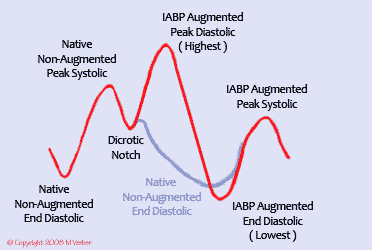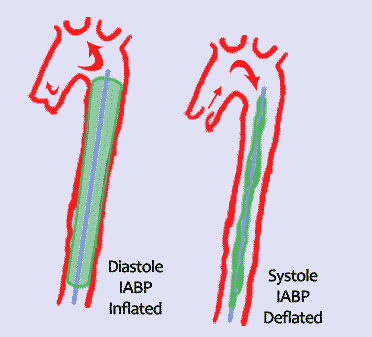IABP: Intra-Aortic Counter Pulsation Balloon Pump
This shows the arterial tracing of a normally functioning IABP
 The nomenclature of IABP pumping can be quite confusing. For the moment we will keep it simple and give each wave a fully
descriptive name.
The nomenclature of IABP pumping can be quite confusing. For the moment we will keep it simple and give each wave a fully
descriptive name.
Note that the diastolic pressure measured during a balloon-assisted cycle is higher than any systolic pressure. Conversely, note that the balloon-assisted systolic pressure is less than the native, non-assisted, systolic pressure.
 This is because of how the IABP works: Inflating during diastole, Deflating during systole. The idea is that diastolic
inflation causes LV endocardial blood flow during diastole, whilst systolic deflation causes reduced impedance
to LV ejection (reduced afterload); and that these two effects result in decreased myocardial oxygen requirements, simultaneous with increased oxygen supply.
This is because of how the IABP works: Inflating during diastole, Deflating during systole. The idea is that diastolic
inflation causes LV endocardial blood flow during diastole, whilst systolic deflation causes reduced impedance
to LV ejection (reduced afterload); and that these two effects result in decreased myocardial oxygen requirements, simultaneous with increased oxygen supply.
The pump is triggered to inflate by either the EKG QRS or the arterial blood pressure wave. The timing needs to be adjusted so that inflation starts precisely at the onset of diastole - ie at the dicrotic notch - and deflation occurs just before systole. Timing errors are both common and dangerous, and can result in acute decompensation or even death.
This all does seem to actually work, but it does not work miracles, and cardiac output generally can only be increased 10-20% with an IABP. The blue line in the illustration above shows the pressure cycle of a non-assisted beat.
Just to Review (assuming 1:2 augmentation: the clearest way to see what is going on):
1) The Goal of Inflation (during diastole) is to create a rapid rise in coronary artery diastolic pressure to allow perfusion of the LV subendocardium:
The IABP should inflate just before the dicrotic notch. The balloon-assisted diastolic pressure should be the highest pressure seen, being higher than both the native non-augmented systolic and the, even lower, balloon-augmented systolic. Likely this is the main physiologic contribution of the IABP.
2) The Goal of Deflation (during systole) is to reduce impedance to LV ejection (afterload):
The IABP should deflate just prior to the opening of the AV. Properly timed, this means that the balloon-augmented end-diastolic is the lowest pressure seen. In particular, the IABP-augmented end-diastolic is less than the native end-diastolic pressure. It also means that the IABP-assisted systolic (ie, the systole following IABP deflation) should be less than the native, non-assisted, systolic pressure. Truly, I do not know how much impedance is reduced by the balloon, compared with a native beat.
Because of the complexity of describing these relationships, every discussion I have ever read on IABP pressures has had at least one mistake. I've been through this weblet several times, but I'll bet that at least one mistake has survived ... however if you think about the physiology involved, you should be able to catch any error.
| < Prev | Next > |